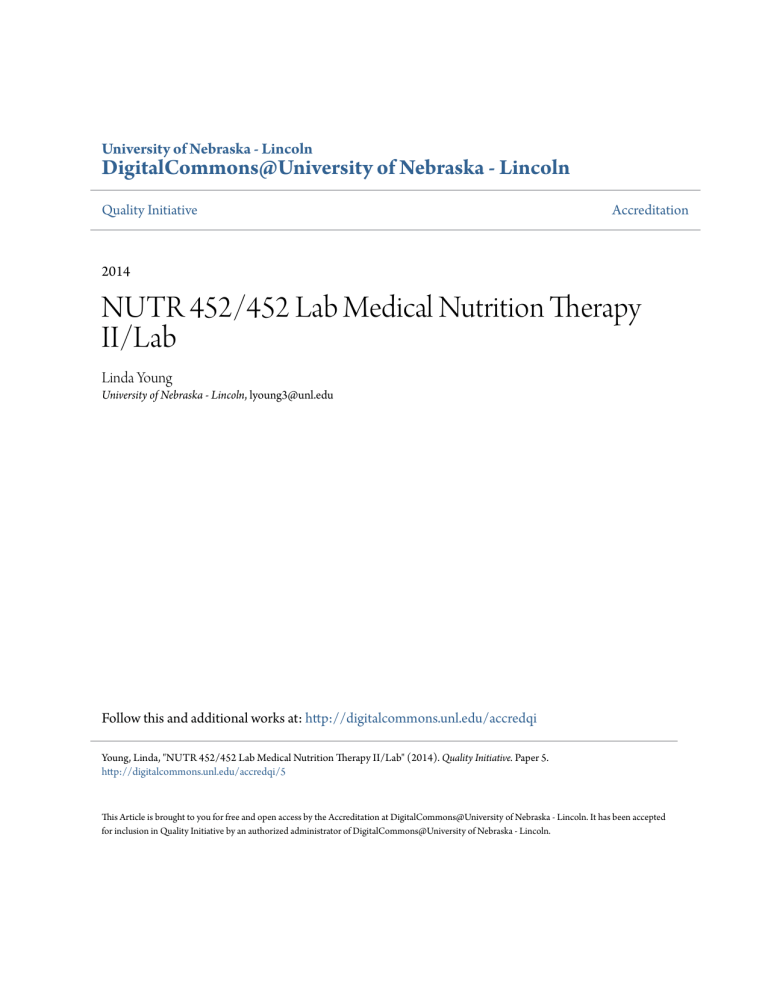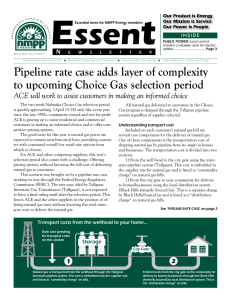NUTR 452/452 Lab Medical Nutrition Therapy II/Lab

University of Nebraska - Lincoln
DigitalCommons@University of Nebraska - Lincoln
Quality Initiative Accreditation
2014
NUTR 452/452 Lab Medical Nutrition Therapy
II/Lab
Linda Young
University of Nebraska - Lincoln , lyoung3@unl.edu
Follow this and additional works at: http://digitalcommons.unl.edu/accredqi
Young, Linda, "NUTR 452/452 Lab Medical Nutrition Therapy II/Lab" (2014).
Quality Initiative.
Paper 5.
http://digitalcommons.unl.edu/accredqi/5
This Article is brought to you for free and open access by the Accreditation at DigitalCommons@University of Nebraska - Lincoln. It has been accepted for inclusion in Quality Initiative by an authorized administrator of DigitalCommons@University of Nebraska - Lincoln.
NUTR 452/452 Lab Medical Nutri6on Therapy II/Lab
Linda Young, MS, RD, LMNT
ACE 10 Ques;on
ACE 10 Ques;on:
Can students demonstrate through the development of a por3olio consis6ng of comple6on of eleven case studies the ability to apply and implement the nutri6on care process in its en6rety?
The student learning outcome addressed in the ACE
10 Ques6on is a learning outcome required for accredita6on of the University of Nebraska-‐Lincoln
Didac6c Program in Nutri6on and Diete6cs:
Students must be able to use the nutri1on care process to make decisions, to iden1fy nutri1on-‐ related problems and determine and evaluate nutri1on interven1ons.
Student Work
Assessment ac6vi6es that occur throughout the semester:
• U6liza6on of the Interna6onal Diete6cs & Nutri6on
Terminology (IDNT) Reference Manual in the implementa6on of the nutri6on care process (NCP)
• Various in lab learning ac6vi6es which reinforce understanding of the various components of the NCP
• Comple6on of nine case studies by student groups
during lab class 6me
• Comple6on of appropriate NCP and medical record documenta6on u6lizing the ADIME format by each student individually for each of the nine case studies
• Comple6on of the NCP and ADIME documenta6on for two case studies completed individually outside of
lab class 6me
Method of Analysis
Student ability to meet the ACE 10 outcome is dependent on the success of various courses in the curriculum in providing the founda6onal knowledge and skills needed to apply the nutri6on care process to the case studies.
A rubric is used to evaluate and provide feedback to the students regarding the extent to which the outcome has been achieved. The rubric also provides informa6on on what aspects of the nutri6on care process students are readily achieving and what aspects con6nue to need further
development.
Informa6on regarding the achievement of the ACE 10 outcome is shared with the department faculty as part of a mee6ng for all Didac6c Program in Nutri6on and Diete6cs faculty which occurs aZer the end of the spring semester.
IDNT Reference Manual
Nutri;on Care Process
Findings
As the semester progresses, students are able to iden6fy meaningful assessment data and iden6fy poten6al nutri6on diagnoses reflec6ve of the
assessment findings.
A challenge for some students is the iden6fica6on of compara6ve standards that need to be u6lized in iden6fying the medical nutri6on therapy interven6on. The ability to do this is influenced by their ability to transfer knowledge gained from other science and nutri6on courses to a specific case study
scenario.
Even at the end of the semester, consistent appropriate construc6on of the nutri6on diagnosis statement iden6fying the problem, e6ology, and signs and symptoms con6nues to allude some students.
Improving ACE 10 Learning
One of the changes relates to NUTR 344
Food and Nutri1on for Healthy Living
which is a course that provides knowledge for the compara6ve standards students need to u6lize as they complete the NCP process. The final exam in that course is now comprehensive reinforcing class content and conveying to students that the course content will be u6lized by them in their professional careers.
To assist with student
’
s understanding and ability to comprehend how the phases of the NCP are interrelated and dependent on each other, the program will ini6ate the use of an electronic medical record simula6on during the
2014-‐2015 academic year. This should assist students in the construc6on of the nutri6on diagnosis statement and its direct rela6onship to the medical nutri6on therapy interven6on and the monitoring of its effec6veness.

